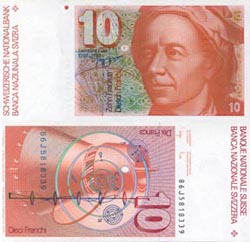Temple commemorates noted mathematician with the purchase of a high-end computer that will assist researchers
 Eighteenth century mathematician and physicist Leonhard Euler's likeness adorns the Swiss 10-franc banknote.
|
In honor of the observance of the 300th birthday of 18th century computational mathematician and physicist Leonhard Euler, the Mathematics Department, together with Computer Services, has purchased a high-end computer that will assist researchers in conducting large-scale computations as part of their research.
The Sun Microsystems computer, which is about half of the approximate size of a four-drawer filing cabinet, features 16 64-bit CPU cores, a single 128 gigabyte memory image and six terabytes (or just over 6,000 gigabytes) of storage. It will be hosted and maintained by computer services and housed on the eighth floor of Wachman Hall. |
|
“Several of our faculty members pointed out that we just didn’t have the computational capacity to carry out certain research,” said Mathematics Department Chair Omar Hijab. “Our computational scientists in the Math Department, in Computer and Information Sciences, in Physics and in Chemistry all expressed an interest in using a supercomputer if we had such a machine. “We applied for tech fee funding from our new dean, Hai-Lung Dai, and he was very generous,” Hijab said. “Later, we thought, why not partner with Computer Services for this computer, and Vice President Tim O’Rourke suggested we pool our resources to enable us to purchase a bigger and better machine, which we did.” “The purchase of this Sun Fire X4600 computer shows outstanding collaboration between the Math Department and Computer Services,” O’Rourke said. “Omar Hijab observed the need for a higher-end computing environment and raised a substantial amount of money for this purpose. Computer Services, understanding the importance of this project, was able to match these funds to get a computer that could meet the ever-increasing processing needs of our academic and research community. “This computer will allow us to target research endeavors that were not possible before,” O’Rourke added. “An additional benefit of this computer is that it will allow Computer Services to replace the aging and obsolete Compute system that has served the faculty and students for many years.” With the new computer, Hijab said that Temple researchers would be able to do large-computations that they are presently unable to carry out. In math, he said, it will assist in such projects as complex electromagnetic permittivity measurements, matrix solutions to noncommutative polynomial equations, multiplicative invariants of symmetric groups, the geometry and combinatorics of zeolites, data analysis and quantum chaos, volumes of spherical polytopes in higher dimensions, and statistical analysis of triangulated graphs. Hijab added that the high-end computer would be useful to the work of other Temple researchers. As an example, he pointed to Zoran Obradovic in Computer and Information Sciences, who has been doing research into bioinformatics and gene sequencing. “This is just the machine they need for that type of research,” he said. O’Rourke added that the new machine has the ability to be clustered with additional nodes that would then classify it as a “super computer.” “If the demand arises, we can expand this system to meet the increased need,” he said. Hijab said the Mathematics Department was planning to host a one-day conference honoring Euler on April 16, the day after the mathematician’s birthday, and decided it would be a nice gesture to also link the purchase of the computer to the Euler celebration. “Euler was a genius at performing amazing computations in his head, especially as he was blind the last two decades of his life,” Hijab said. “His legacy is everywhere in mathematics, notably in calculus, number theory, topology and complex analysis.” |
|